Novel cost-effective framework for autonomous vehicle infrastructure
Simulating time-variant channel impulse response for mmWave I2I channels using Doppler spread information
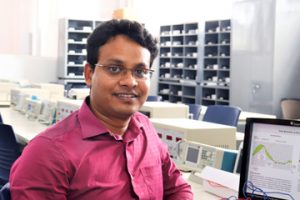 Dr Anirban Ghosh
Dr Anirban Ghosh
Dr Anirban Ghosh, Assistant Professor, Electronics and Communication Engineering, has recently published a paper titled “Time Variance of 60 GHz VI2I channel”. The paper is published in the renowned journal Elsevier-Vehicular Communication with an Impact Factor of 4.7. This paper explores the implementation challenges in unlicensed 60 GHz frequency band for autonomous vehicle infrastructure. This work has been implemented in collaboration with his colleagues from NIT Durgapur and collaborators from Brno University under the aegis of Prof. Ales Prokes. This work is also funded by the Science Foundation grant (Czech) and National Sustainability Program grant (Czech) and DST-Core Research Grant(India).
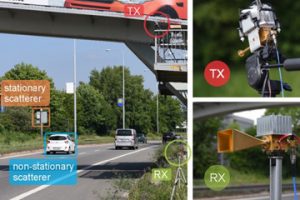 Fig 1: Field test setup at the measurement site
Fig 1: Field test setup at the measurement site
Smart cities are cities on the move; having a mission of delivering people and goods with zero congestion, zero fatality and zero energy wastage. For realising this mission, a smart city needs an intelligent transport system (ITS). As far as the communication aspect of ITS is concerned, historically, the urban ITS planners were more concerned about vehicle-to-vehicle (V2V) and vehicle-to-infrastructure (V2I) modes of communication. This is because the V2V and V2I channels are essentially wireless, and establishing reliable low-latency links over these channels is challenging. Infrastructure-to-infrastructure (I2I) communication is also an integral part of the ITS initiative, and due to their rapid, dynamic and non-invasive nature of the installation, wireless I2I links are preferred over wired links in several smart-road based ITS applications. In order to implement wireless I2I communication, transceivers may be fitted with different kinds of roadside units (RSUs), e.g., short height traffic signposts, overhead gantries, and cantilever sign supports. The traditional role of these RSUs is to support the basic ITS goals, i.e. driver assistance or traffic management. As the vehicular networks scale-up, ITS computations are being shifted to the edge, and the RSUs are going to play more prominent roles in the form of edge computing devices. For example, RSUs can form the cloudlet layer of a vehicular fog computing (VFC) architecture for the internet of vehicles (IoV).
Vehicular wireless I2I channels realise fixed-to-fixed (F2F) radio communication between two RSUs. For any F2F radio channel with stationary transmitter (TX) and receiver (RX), the time-variance is caused by the mobility of the scatterers. These mobile scatterers, say passersby for an indoor scenario, or passing vehicles for an outdoor scenario, cause changes in path lengths in a fading multipath channel. When viewed in frequency-domain, this yields a change in carrier frequency termed as Doppler shift which is proportional to the velocity of the scatterer, and the spectral broadening caused by the time rate of change of the channel is measured with the Doppler spread. Information about Doppler spread is critical for V2V applications such as platooning. In the context of V2I applications, accurate estimation of the Doppler spread is required for designing adaptive transceivers, smart antennas and for determining cellular handoffs. Doppler spread information can also be used for I2I applications like speed estimation. The radar-based solution has a lower latency compared to a camera-based solution, owing to the video acquisition and processing time of the later. As the Doppler shift is a linear function of the carrier frequency, it is of greater concern while moving up in the frequency ladder to the millimetre wave (mmWave) regime. The Doppler spread in the unlicensed 60 GHz mmWave band would be 10-30 times that in the current sub-6 GHz band, with a range spanning from 10 Hz to 20 kHz depending on the velocity of the scatterers. Moreover, compared to V2V links, the effect of moving scatterers is much more pronounced in F2F links; walking pedestrians with a velocity order of ∼ 1 m/s or even the tree leaves fluttering in the wind are important for F2F channel modelling. For highways, the moving vehicles have a velocity an order higher (> 10 m/s) and contribute significantly to the time-variance of the roadside wireless I2I links.
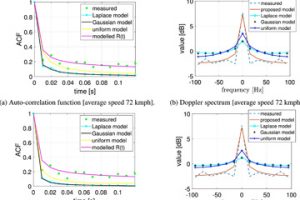 Fig 2: Comparison of the measured and
Fig 2: Comparison of the measured and
proposed models of ACF and Doppler
Spectrum with existing analytical models
In this paper, Dr Ghosh studied the time-variance of a roadside infrastructure to infrastructure (I2I) channel operating at 60 GHz millimetre wave (mmWave) band, where the time-variance is caused by moving vehicles acting as scatterers. At first, measurement data is obtained by placing the transmitter (TX) and the receiver (RX) at different heights to emulate a link between two nonidentical roadside units (RSUs), and time-domain channel sounding is performed by sending complementary Golay sequences from the TX to the RX. A linear piecewise interpolation of the corresponding temporal auto-correlation function (ACF) is used to find the Doppler spread of the I2I channel, where their interpolation method compensates for a slower sampling rate. Next, a framework is presented for the time-variant channel impulse response (CIR) simulation, which focuses on moving scatterers only and validates the linear piecewise ACF model. The framework is useful for time-variant vehicular I2I channel simulation and in speed estimation related vehicular applications. Finally, a double-slope curve-fitted analytical model for ACF is proposed as a generalisation to the linear piecewise model. The proposed model and its Doppler spectrum are found to be in agreement with the analytical results for fixed-to-fixed (F2F) channels with moving scatterers and matches perfectly with the measured data. “Our research has explained a framework for simulating time-variant channel impulse response (CIR) for mmWave I2I channels with moving scatterers using Doppler spread information – which provides means to study the various characteristics of an I2I channel even without carrying out any expensive channel sounding campaign”, said Dr Ghosh.
Dr Ghosh and his collaborators are currently exploring further challenges in communication between vehicles (V2V) in the same frequency range (60 GHz).
To know more about the paper, please visit- https://www.sciencedirect.com/science/article/abs/pii/S2214209620300590?dgcid=coauthor
- Published in ECE NEWS, Faculty, News, Research News
Students certified on successfully completing outreach programmes organized by IIRS-ISRO
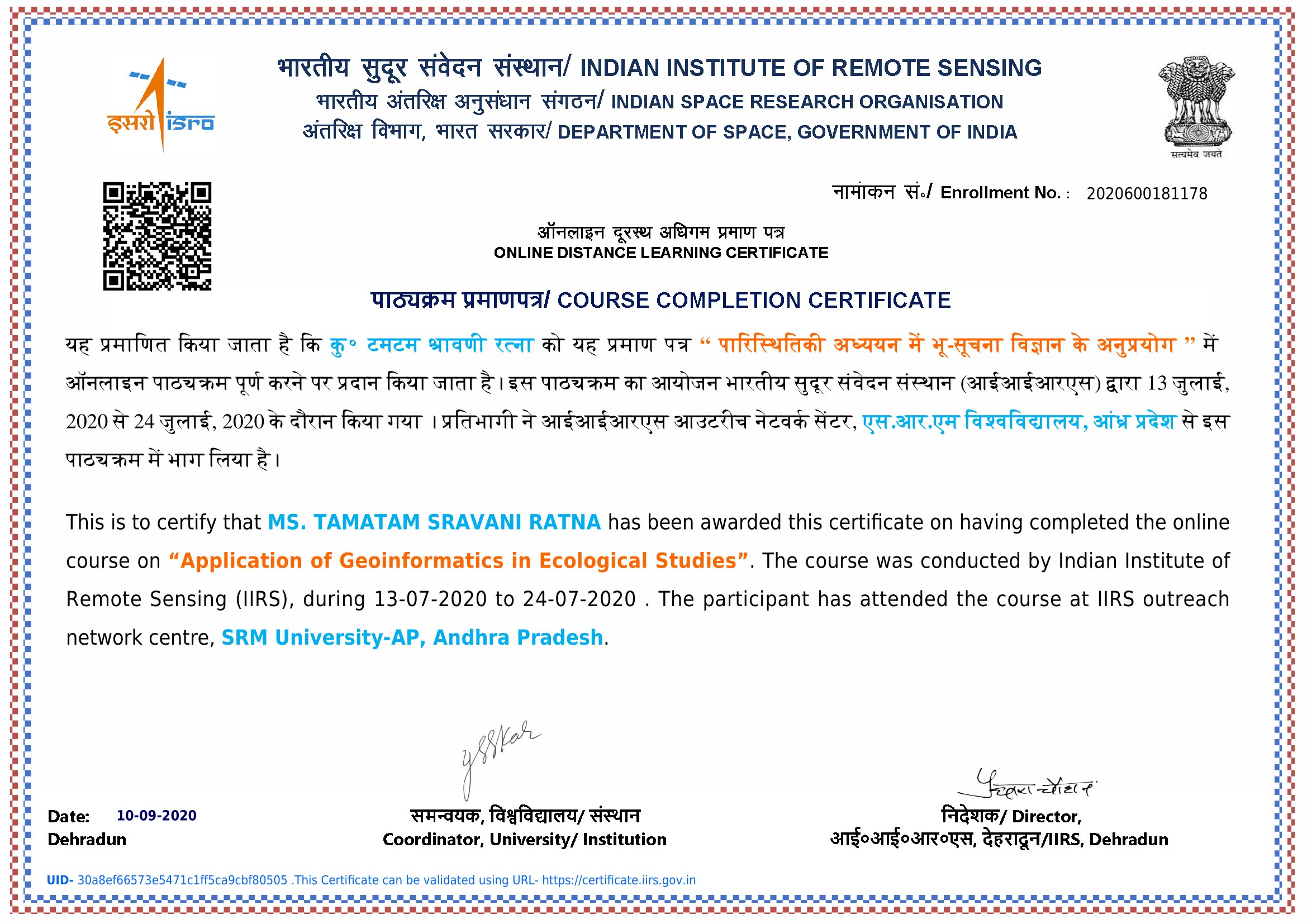
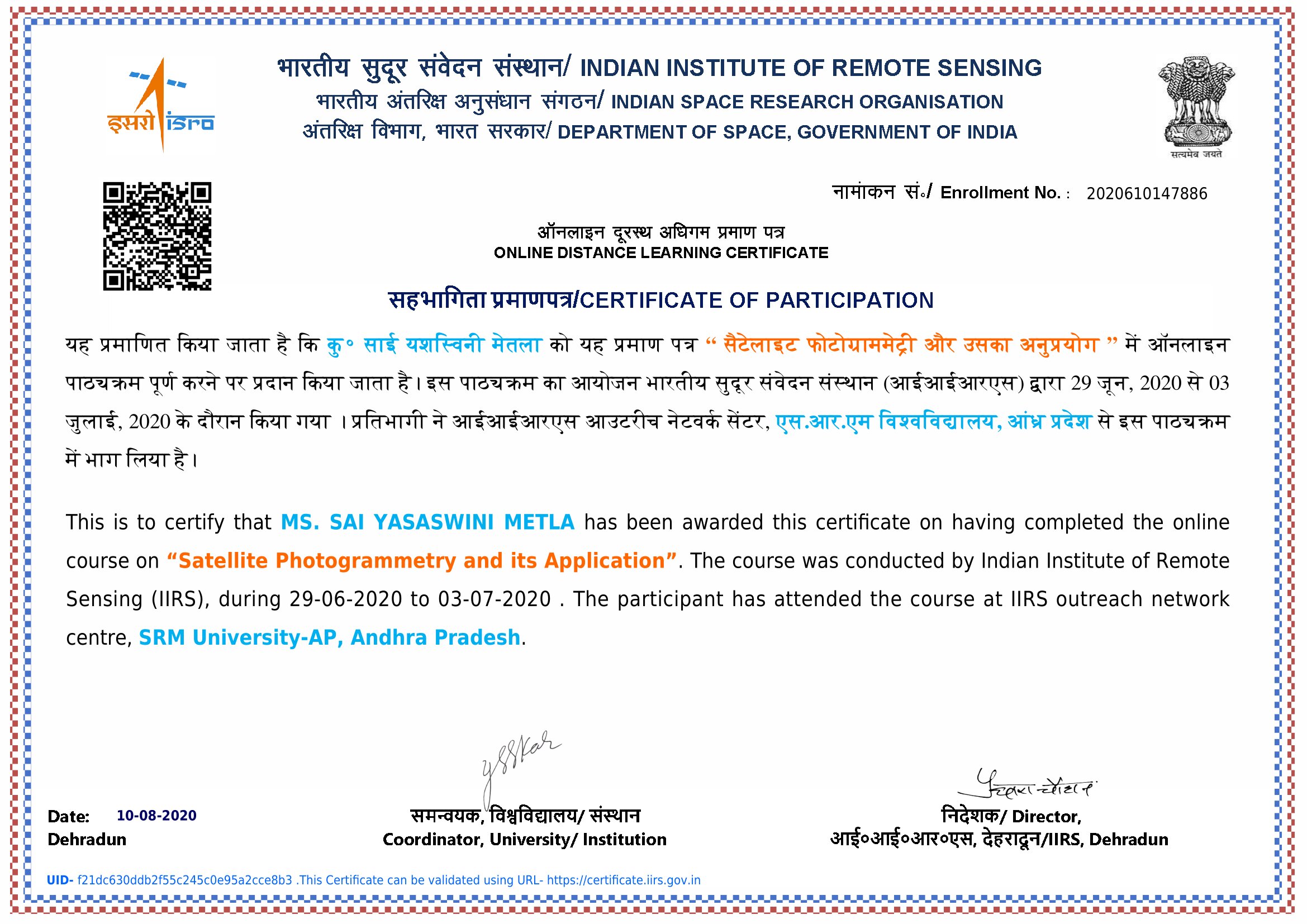
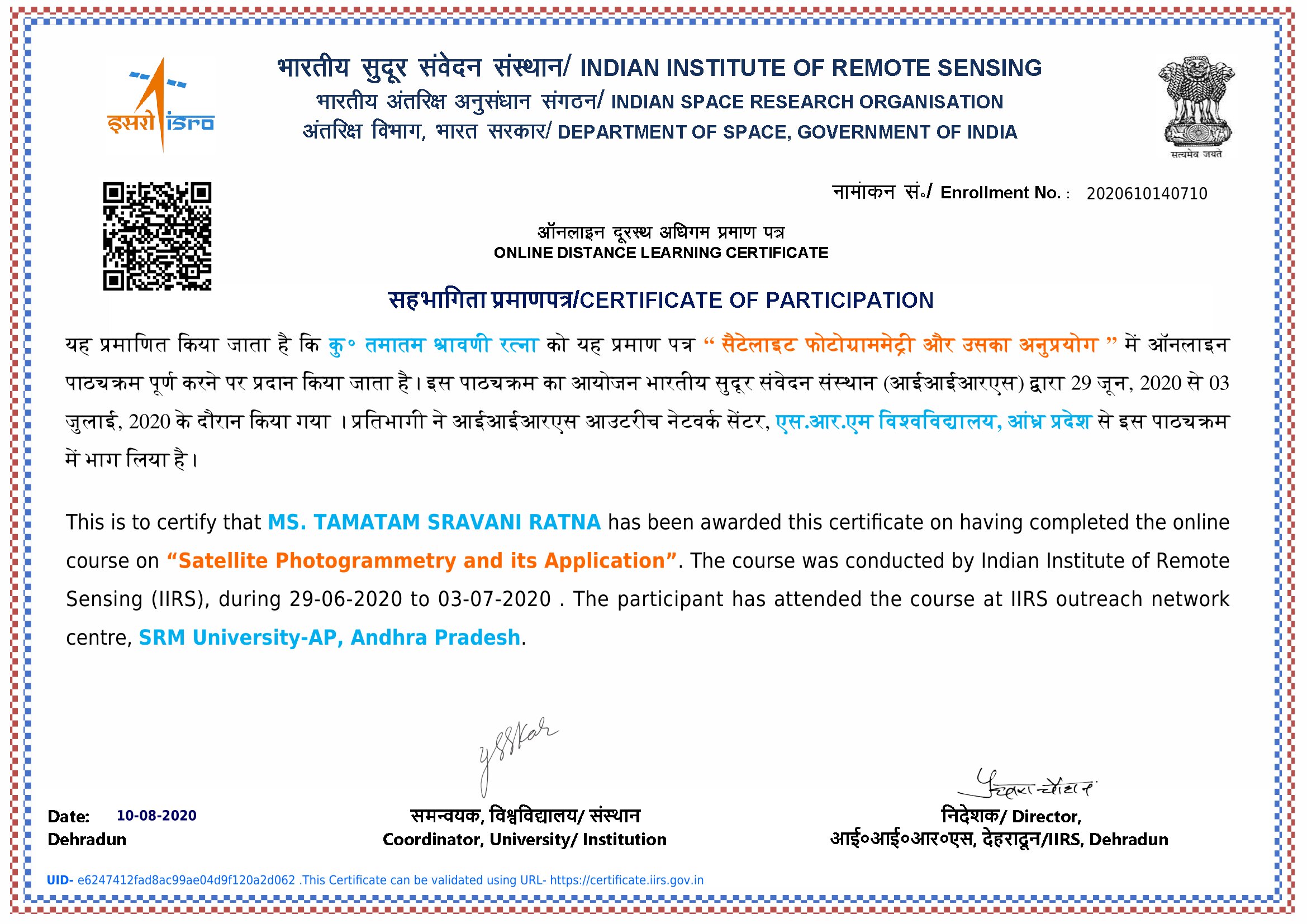
SRM University AP-Andhra Pradesh has collaborated with the Indian Institute of Remote Sensing (IIRS) -Indian Space Research Organization (ISRO)’s outreach programme. As part of the association, the students of SRM AP have the excellent opportunity to register for annual courses as well as live and interactive programmes being organized by IIRS-ISRO.
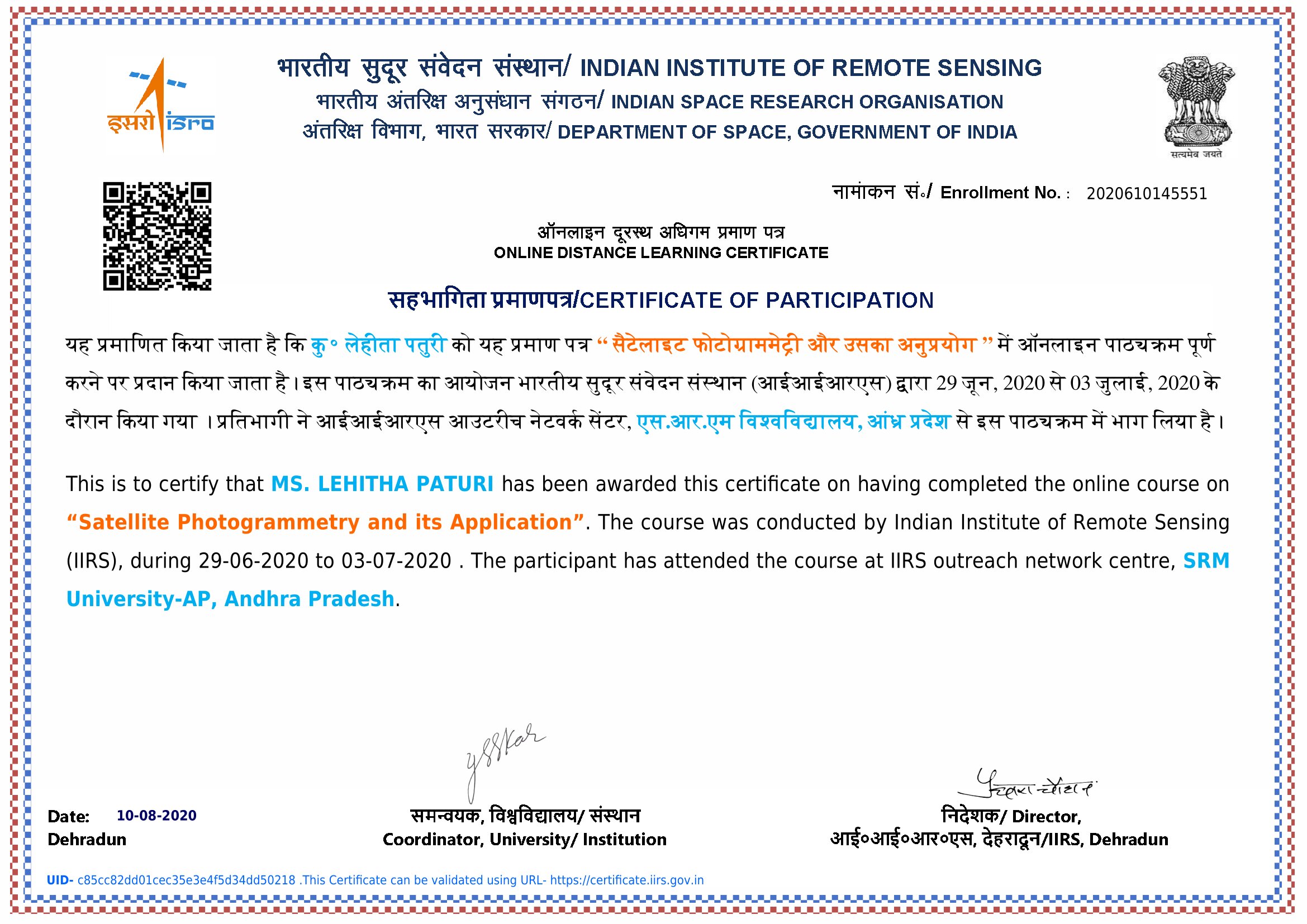
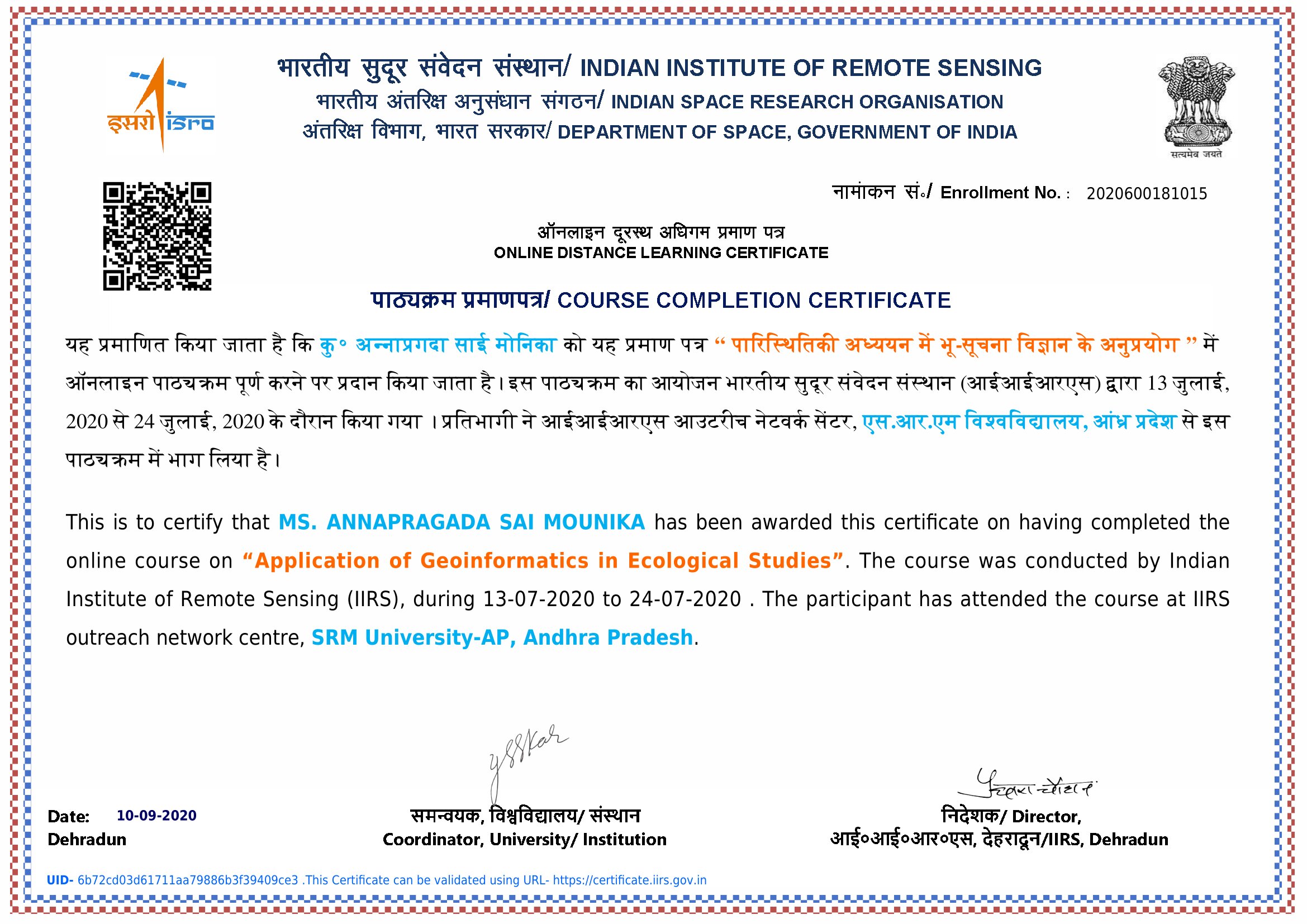
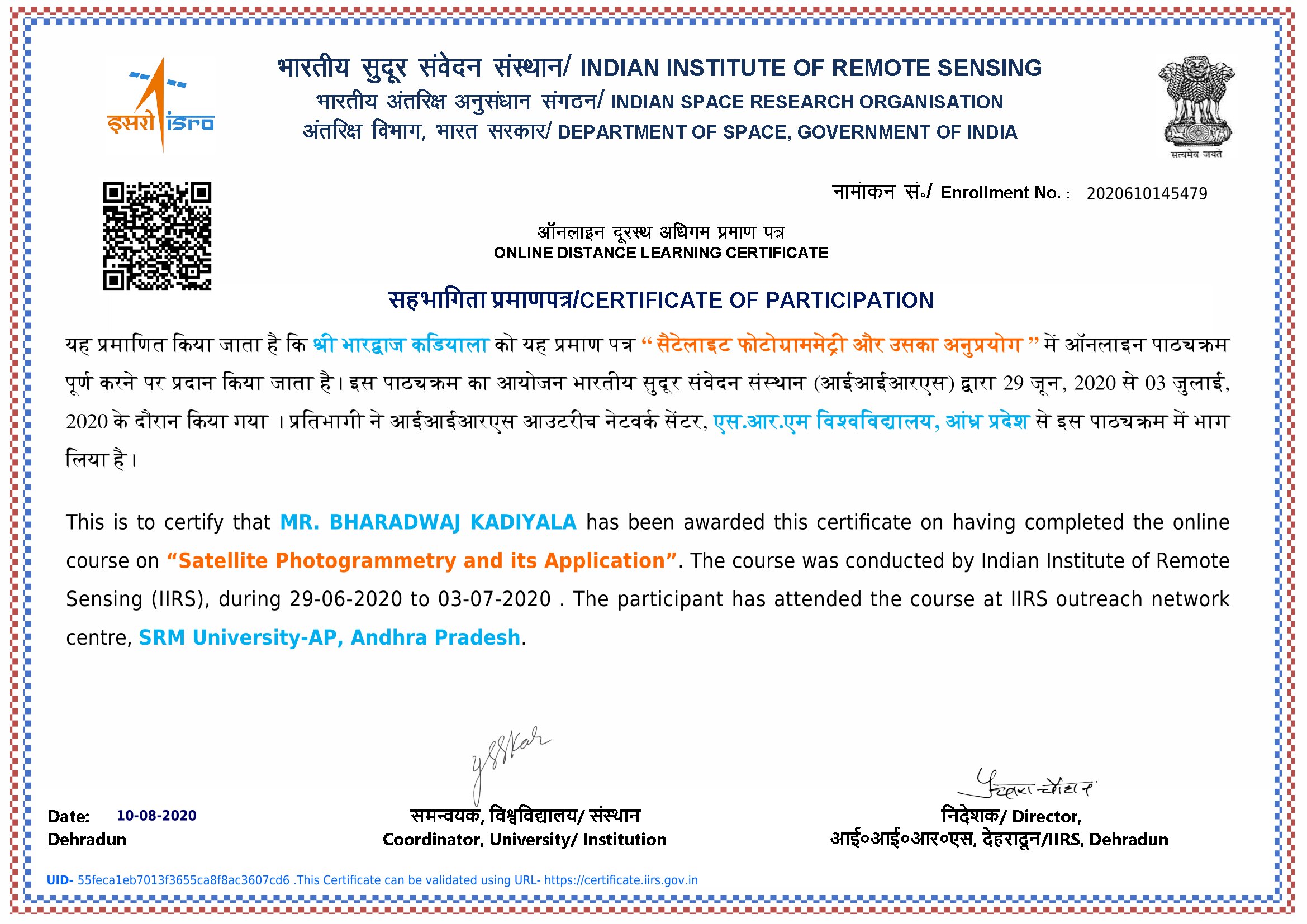
SRM AP encourages the students to proactively avail the interactive distance learning courses and webinars that will enable them to achieve their career goals in aerospace and geospatial technologies and make a mark globally.
- Published in ECE Events, ECE NEWS, News
ECE Student sets sail to King’s College, London for Masters studies
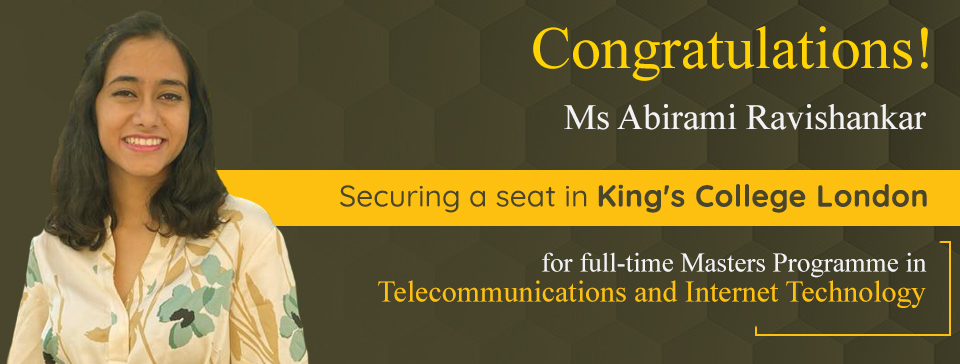 Nothing brings more pleasure than seeing our students being recognised in the best educational institutions abroad. Ms Abirami Ravishankar has secured a seat in King’s College London for their full-time Master’s Programme in Telecommunications and Internet Technology. She is in the final year of B. Tech in the Department of Electronics and Communication Engineering. The duration of the Master’s programme is one year, and she will be joining her programme in September 2021.
Nothing brings more pleasure than seeing our students being recognised in the best educational institutions abroad. Ms Abirami Ravishankar has secured a seat in King’s College London for their full-time Master’s Programme in Telecommunications and Internet Technology. She is in the final year of B. Tech in the Department of Electronics and Communication Engineering. The duration of the Master’s programme is one year, and she will be joining her programme in September 2021.
King’s College, London is well known throughout the world for its eminence. It is one of the top institutes with high QS ranking. Abirami informed that the admission process in such a reputed institute is very rigorous and challenging. King’s College, London accepts only 10% of all the applications each year. “The sheer credit goes to my professors who briefed me on the admission process and guided to crack it. Thanks to the incredible learning experience at SRMAP, I was able to achieve a thorough understanding in my subjects, which helped me immensely during my application days. King’s College, London minutely judges the applicant’s overall knowledge and depth before offering them admission. However, for me, it was no tough job because of my excellent grooming here at SRMAP. I sincerely thank all my professors for all their efforts in making me a good engineer, and now I wish to avail this opportunity to prosper and make a difference to the world in the coming days,” says Abirami, deeply overwhelmed.
“We are very happy for Abirami for her enrolment in the Master’s programme at King’s College, London. We, the faculty of SRMAP, always strive to provide best guidance and support to our students. Abirami is a meritorious student who aspires to do something for herself as well as for the community. We wish her all the best for her future. She can always count on our support whenever she needs it,” said Prof Siva Sankar Yellampalli, who has closely witnessed Abirami throughout the years of her undergraduate studies. Prof Yellampalli is also the Professor and Head in the Department of Electronics and Communication Engineering.
- Published in Departmental News, ECE NEWS, News, Students Achievements
ECE Undergrads developed AI-based communication app for deaf and blind
Won prestigious i-Hack Alpha with a cash prize of $2300
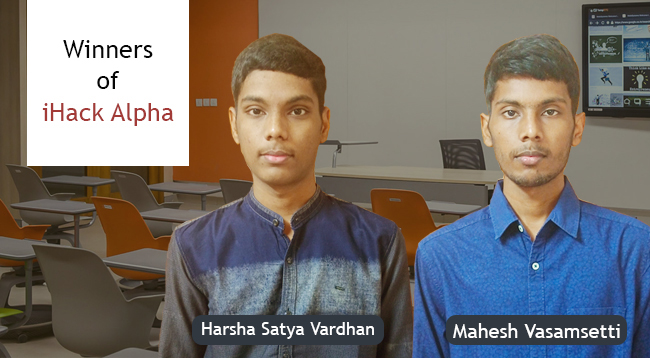 Department of Electronics and Communication Engineering rejoices in the exhilarating success of Harsha and Mahesh, the winners at iHack Alpha Hackathon. iHack Alpha was an AI-Hackathon, where developers from all backgrounds were invited to solve real-world problems with innovative AI solutions powered by sentient.io AI and Data platform. Unlike the usual hackathons, it was conducted over three weeks, starting from December 2, 2020, and finished on December 27, 2020, and participants were supposed to present a full-fledged application. Four themes were given to participants to work on in the hackathon- 1) Use of AI in retail 2) Use of AI in Customer service 3) Use of AI in media 4) Use of AI in Accessibility.
Department of Electronics and Communication Engineering rejoices in the exhilarating success of Harsha and Mahesh, the winners at iHack Alpha Hackathon. iHack Alpha was an AI-Hackathon, where developers from all backgrounds were invited to solve real-world problems with innovative AI solutions powered by sentient.io AI and Data platform. Unlike the usual hackathons, it was conducted over three weeks, starting from December 2, 2020, and finished on December 27, 2020, and participants were supposed to present a full-fledged application. Four themes were given to participants to work on in the hackathon- 1) Use of AI in retail 2) Use of AI in Customer service 3) Use of AI in media 4) Use of AI in Accessibility.
Harsha and Mahesh chose to work on the use of AI in the Accessibility theme, where they were asked to build an AI – solution using the sentient.io services. The whole hackathon was divided into three phases 1.) Ideation Phase 2) Build Phase 3) Finals.
Around 1083 teams participated across countries such as India, Malaysia, the Philippines, Indonesia, and Singapore.
Harsha and Mahesh found their inspiration in the story of Helen Keller and decided to build an app with ease of accessibility for the blind and deaf persons. As Annie Sullivan used to help Helen in her communication, Harsha and Mahesh thought, why can’t they create an app which can be installed on the mobile phone and will do the same! The duo turned this crazy idea into reality by developing Artificial Voice- a communication app for the blind and deaf. Artificial Voice is a bidirectional communication app for the deaf and blind to send and receive messages with the help of AI-based technology such as Automatic Speech recognition, Text to speech converter, Audio format converter.
The whole Hackathon was broadcasted online. Harsha and Mahesh’s presentation on Artificial Voice received high praise and acclaims from the judges, and the Team SRMAP(aka Team Square) secured first place in the prestigious i-Hack Alpha hackathon with a grand cash prize of $2300. Harsha is currently pursuing his 3rd year B. Tech Studies whereas Mahesh is in the 2nd year of his undergraduate studies at the Department of Electronics and Communications Engineering. “This success at i-Hack Alpha hackathon has boosted our confidence. We are working on better versions of the app and some other projects that can contribute to society,” said Harsha.
- Published in Departmental News, ECE NEWS, News, Students Achievements
ECE Students admitted to prestigious universities across the globe
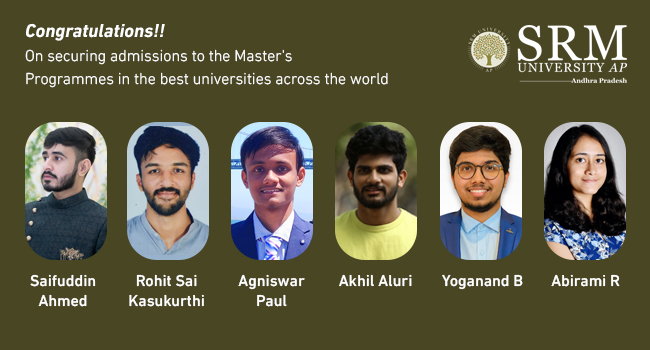 The Department of Electronics and Communication at SRM University-AP, Andhra Pradesh, is overjoyed to announce its students’ success in pursuing higher education. Six students from the maiden batch have performed brilliantly and been accepted to prestigious universities in the United States. These students are offered the opportunity to pursue a master’s degree in their chosen fields. Four of the six pupils have been accepted to New York University, and the remaining two are admitted to The University of Wisconsin-Madison and Georgia Institute of Technology in the United States of America.
The Department of Electronics and Communication at SRM University-AP, Andhra Pradesh, is overjoyed to announce its students’ success in pursuing higher education. Six students from the maiden batch have performed brilliantly and been accepted to prestigious universities in the United States. These students are offered the opportunity to pursue a master’s degree in their chosen fields. Four of the six pupils have been accepted to New York University, and the remaining two are admitted to The University of Wisconsin-Madison and Georgia Institute of Technology in the United States of America.
Saifuddin Ahmed, Akhil Aluri, Rohit Sai K, and Abirami Ravishankar have been awarded a handsome annual scholarship from New York University. The host university offered a grant of $10,000, $8000, $8000, and $11000, respectively. Among the four students, Saifuddin, Akhil, Rohit and Abirami, the first three opted for a master’s in Management of Technology and Abirami enrolled in the Department of Electrical Engineering. Agnishwar Paul is selected by Georgia Tech University while B Yogananda took admission in the Master’s-Research Programme at The University of Wisconsin-Madison. Yogananda has received an offer for Teaching Assistantship from University of Wisconsin, Madison and as a part of it, he will also be receiving a Monthly Stipend and full Tuition Fee Wavier.
Students indicated that the in-depth knowledge that they gained during their B. Tech studies made them very confident while applying for higher studies. Agniswar said, “The curriculum that is followed in the university is up-to-date and at par with reputed global universities. It helped me a lot to catch up with the expectations of my preferred university.” Saifuddin added, “I was a bit doubtful at first whether to pursue higher studies after graduation. But the sincere guidance of Dr Sunil Chinnadurai and Higher Connect Club invoked the hunger in me to seek more knowledge.”
Higher Connect Club (HCC) is the university’s dedicated wing to connect all ECE students interested in pursuing Higher Education after they graduate from SRM University – AP. This club is focused on clarifying all the doubts that usually arise in a student’s mind when pursuing higher education and provides required support with all the resources required, guiding in the best possible way.
“My professors helped me to come up with the right strategy to score well in GRE. All of our teachers have international exposures. It helped a lot during our preparations for higher studies,” said Yogananda. Apart from strong grades in undergraduate courses, selection rounds of interviews needed proficiency in work experience and extracurricular activities. “The experience we gained during the Semester Abroad Programme and Capstone Projects added value to the resume, which helped us tremendously to prove our merit,” asserted Abirami.
The Department of ECE is pleased with students’ accomplishments and encourages future batches to emulate them, bringing honour to SRM University-AP, Andhra Pradesh. Prof Siva Sankar Yellampalli, Head of the Department, said, “We are proud of our students. The first batch is about to graduate. We feel saddened to bid them goodbye, but at the same time, it makes me extremely happy to know that they are going to pursue their chosen paths. My best wishes are always with them.”
- Published in ECE NEWS, News, Students Achievements
Application-driven industrial-scale manufacturing of Li/Na-ion battery cathodes
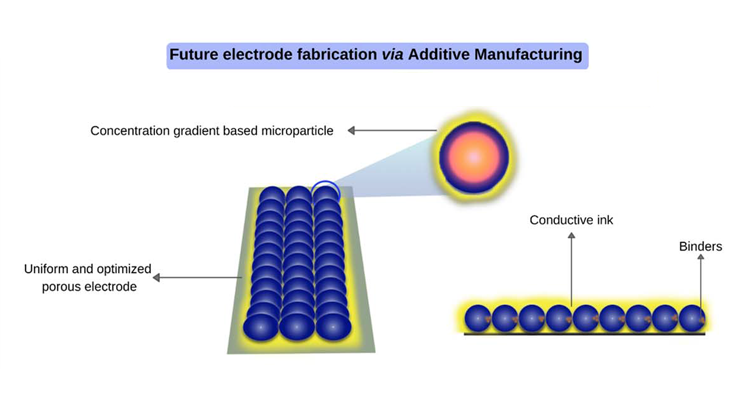 The advent of the industrial revolution increased the dependency of humans on fossil fuels which led to an increase in environmental degradation. While alternative energy sources such as wind, solar and hydro seem to be good options, their uncertainty in delivering the power made Dr Sujith Kalluri, Assistant Professor in the Electronics and Communication Engineering Department and his PhD scholar Chanakya Karra at SRM University-AP prefer batteries as a viable option. “Application-driven Industrial-scale Manufacturing of Li/Na-ion Battery Cathodes” is a paper published by Dr Sujith Kalluri and Mr Chanakya Karra in the Journal of The Electrochemical Society having an Impact Factor of 3.721 as part of their project to develop zero-emission energy methods.
The advent of the industrial revolution increased the dependency of humans on fossil fuels which led to an increase in environmental degradation. While alternative energy sources such as wind, solar and hydro seem to be good options, their uncertainty in delivering the power made Dr Sujith Kalluri, Assistant Professor in the Electronics and Communication Engineering Department and his PhD scholar Chanakya Karra at SRM University-AP prefer batteries as a viable option. “Application-driven Industrial-scale Manufacturing of Li/Na-ion Battery Cathodes” is a paper published by Dr Sujith Kalluri and Mr Chanakya Karra in the Journal of The Electrochemical Society having an Impact Factor of 3.721 as part of their project to develop zero-emission energy methods.
Through this article as a platform, the authors focus on three aspects of energy storage devices that are essential while the world is catapulted to upgrade itself from fossil fuels to electric vehicles. From a battery level perspective, they have discussed the dependence of the battery industry on lithium-ion technology and its repercussions. As a solution, they suggest the distribution of the dependency on sodium-ion technology owing to its adaptability and wide availability. From the cathode level perspective, the paper suggests co-precipitation through the CSTR as a customized solution to address the setbacks in the synthesis process and additive manufacturing as a preferred solution to cater for the desired electrode design specifications that would comply with the needs of future generations and the industry. Till the battery energy storage system paves the way for Na to take over, we can reckon on SC-NCM cathode material to serve the needs.
Read the full paper here: https://iopscience.iop.org/article/10.1149/1945-7111/abfab6/pdf
More about the Battery research project of SRM University-AP:https://srmap.edu.in/seas/electronics-and-communication-engineering/research-areas/battery-research/
- Published in Departmental News, ECE NEWS, News, Research News
Dr Sarita Vig on “Wonders of Cosmos”
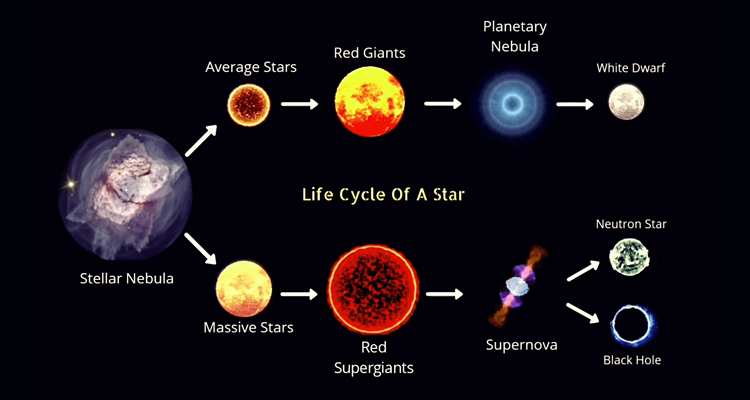 Electronics and Communication Engineering (ECE) department of SRM University-AP in association with The Institute of Engineers (India), AP State Chapter and the Institution of Electronics and Telecommunication Engineers (IETE) Vijayawada Chapter has conducted a webinar titled “Wonders of Cosmos” on Saturday, April 17, 2021, at 3.00 pm through Zoom. The guest speaker Dr Sarita Vig from the Department of Earth & Space Sciences at IIST, Thiruvananthapuram, Kerala highlighted the basics of astronomy enlightening on the fundamentals and overview of the high-end telescopes found globally.
Electronics and Communication Engineering (ECE) department of SRM University-AP in association with The Institute of Engineers (India), AP State Chapter and the Institution of Electronics and Telecommunication Engineers (IETE) Vijayawada Chapter has conducted a webinar titled “Wonders of Cosmos” on Saturday, April 17, 2021, at 3.00 pm through Zoom. The guest speaker Dr Sarita Vig from the Department of Earth & Space Sciences at IIST, Thiruvananthapuram, Kerala highlighted the basics of astronomy enlightening on the fundamentals and overview of the high-end telescopes found globally.
Addressing the session, Dr CV Sriram, Hon. Secretary of IEI APSC opened the virtual podium to other dignitaries. Dr Geetha Devi from IETE introduced Dr Sarita Vig; Er. Kalee Prasad, Honourable Secretary; and Dr Ramanjaneyulu Fiete, Chairman of IETE. Dr Sujith Kalluri from the ECE department at SRM University-AP was the coordinator and organiser of the event.
Dr Sarita in her presentation elaborated on the different types of telescopes and observatories such as the CGRO, HST, SIRTF, CHANDRA. She discussed the elements responsible for the inception of the universe and the astrophysical processes behind it. Further, she talked about other planets which can be considered as a potential place for habitat like our earth. She also mentioned the supernova remnant crab nebula which was exploded billions of years ago and was even witnessed in the daylight, as per Chinese and Mexican researchers.
Towards the end of the session, Dr Sarita presented the facts about the black hole in the centre of the massive galaxy M87. “In 2019, Event Horizon Telescope helped to get the image of the black hole in radio wavelength. The universe is expanding and it is not in a static form,” she said. The webinar came to an end with an interactive Q&A session between the panellists and participants.
ECE students accomplish international internship in Canada
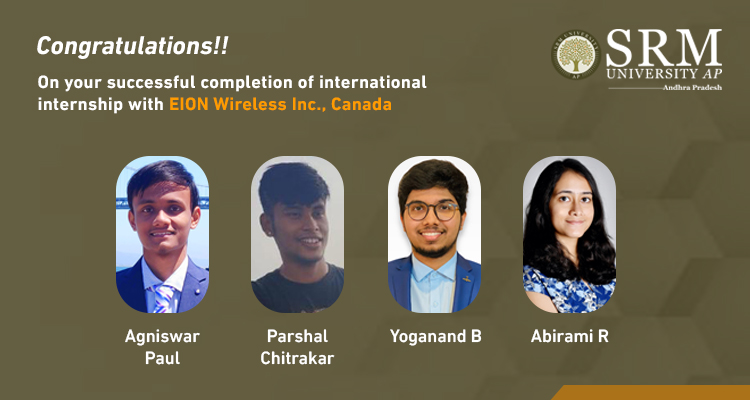 Yoganand B, Parshal Chitrakar, Agniswar Paul, Abirami Ravishankar are four brilliant students from the Department of Electronics and Communication Engineering at SRM University-AP who have successfully completed an international internship with EION Wireless Inc, Canada. The students worked as engineering interns with this reputed wireless solutions firm in Canada for five and a half months (Jan 15- June 30) obtaining an internship salary of 500 CAD per student every month. Through this opportunity, the students could build a system that is able to send data to long distances.
Yoganand B, Parshal Chitrakar, Agniswar Paul, Abirami Ravishankar are four brilliant students from the Department of Electronics and Communication Engineering at SRM University-AP who have successfully completed an international internship with EION Wireless Inc, Canada. The students worked as engineering interns with this reputed wireless solutions firm in Canada for five and a half months (Jan 15- June 30) obtaining an internship salary of 500 CAD per student every month. Through this opportunity, the students could build a system that is able to send data to long distances.
Selection Process:
a. Internal selection: Based on the CV and projects undertaken, the ECE Faculty conducted interviews and shortlisted the students.
b. Personal Interview: The shortlisted students attended the interview with the company in which, the company scrutinised their project, skills, and whether they were relevant to the company’s requirements.
c. Techincal Interview: This round focused on analysing technical skills. A technical problem statement was given to members and was asked to come up with a solution in 10 minutes.
d. Coding test: In this round, coding questions were distributed and students had to submit documents of output and on how the code was processed.
For engineering graduates, technical skills and hands-on experience with industry is inevitable. SRM University-AP ensures that every student grabs opportunities to excel in their respective disciplines.
Student Testimonial- Parshal Chitrakar:
I would like to thank the faculty of the ECE Department at SRM AP for this great opportunity. Being a part of this internship programme by EION wireless has been one of my first and best experiences in the industry. Being a fresher, this opportunity gave me a chance to apply my knowledge and skills in developing real-time applications. This five and a half months internship taught me different ways to look at things, work with people from diverse backgrounds, and helped me develop my technical as well as soft skills. Before this, I was focused only on personal achievements, but when we work for a company it has to be focused on the public demand and common good. I think this is the main difference between academia and industry. There is no such difference between academic-based projects and industry-based projects; it is just how we think, showcase our abilities and how our work reaches the target stakeholders.
- Published in Departmental News, ECE NEWS, News, Students Achievements
Vivek Vardhan from ECE files design copyright
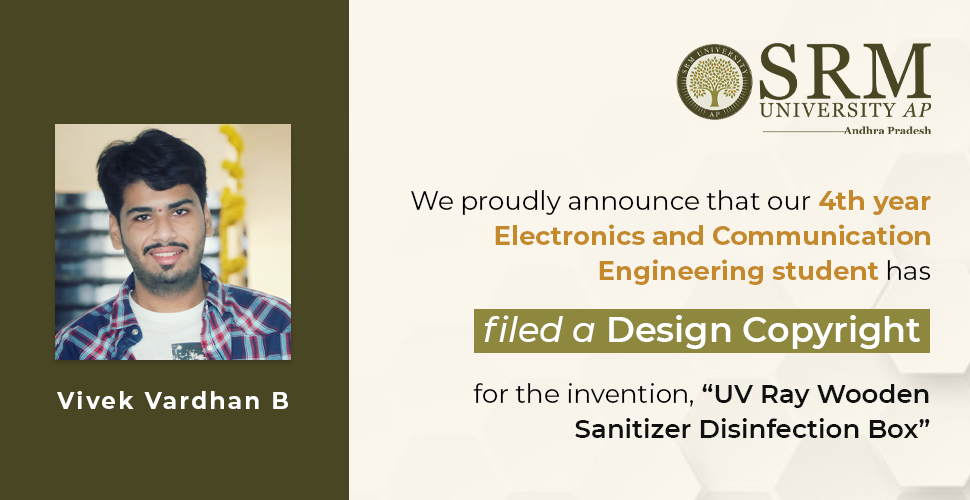 Bitragunta Vivek Vardhan, a final year student from the Department of Electronics and Communication Engineering, has filed a design copyright for developing a “UV Ray Wooden Sanitizer Disinfection Box”. This is a safe chemical-free product designed to disinfect the surfaces of items. In this period of the Covid-19 pandemic, it has been difficult to sanitize mobile phones, tabs, laptops, car/bike keys, wallets, currency/coins, credit/debit cards, newspapers, pens, goggles, spectacles, accessories, milk packets, bakery items, water-absorbing products, delivery packages, toys, clothes etc with liquid sanitisers or else with water.
Bitragunta Vivek Vardhan, a final year student from the Department of Electronics and Communication Engineering, has filed a design copyright for developing a “UV Ray Wooden Sanitizer Disinfection Box”. This is a safe chemical-free product designed to disinfect the surfaces of items. In this period of the Covid-19 pandemic, it has been difficult to sanitize mobile phones, tabs, laptops, car/bike keys, wallets, currency/coins, credit/debit cards, newspapers, pens, goggles, spectacles, accessories, milk packets, bakery items, water-absorbing products, delivery packages, toys, clothes etc with liquid sanitisers or else with water.
Researchers say that the coronavirus stays on surfaces of plastic (3-7 days), stainless steel (3-7 days), copper (up to 4 hours), paper (up to 4 days), glass (4 days), cardboard (24 hours), and wood (up to 2 days). UVC has a wavelength of 10 nm to 400 nm and is used for the disinfection method that has short-wavelength light to kill or inactivate microorganisms by destroying nucleic acids and disrupting their DNA, leaving them unable to perform vital cellular functions. The UVC light used in the product will not penetrate into solid surfaces and it is safe to use on touchscreen mobiles, laptops, tabs, etc. It is also proven that the disinfection box can destroy the bacteria and viruses on the surface of food items without causing any harm to the edibility.
“In future, I have plans to take this project to the next level by designing large dimensions of the box and making it work automatically with remote control through our mobile phone. I am extremely happy about filing the copyright and I express my heartfelt gratitude to Prof Siva Sankar Sir and Pro VC Prof D Narayana Rao Sir for giving me the opportunity and supporting me to expand my idea up to the level of implementation. And I thank Prof Vinod Kumar Sir for taking care of the filing process. Finally, I thank SRM University-AP for encouraging and nurturing young talents in all ways possible, “ Vivek stated.
- Published in Departmental News, ECE NEWS, News, Research News, Students Achievements
Final year students get placed in ZS Associates
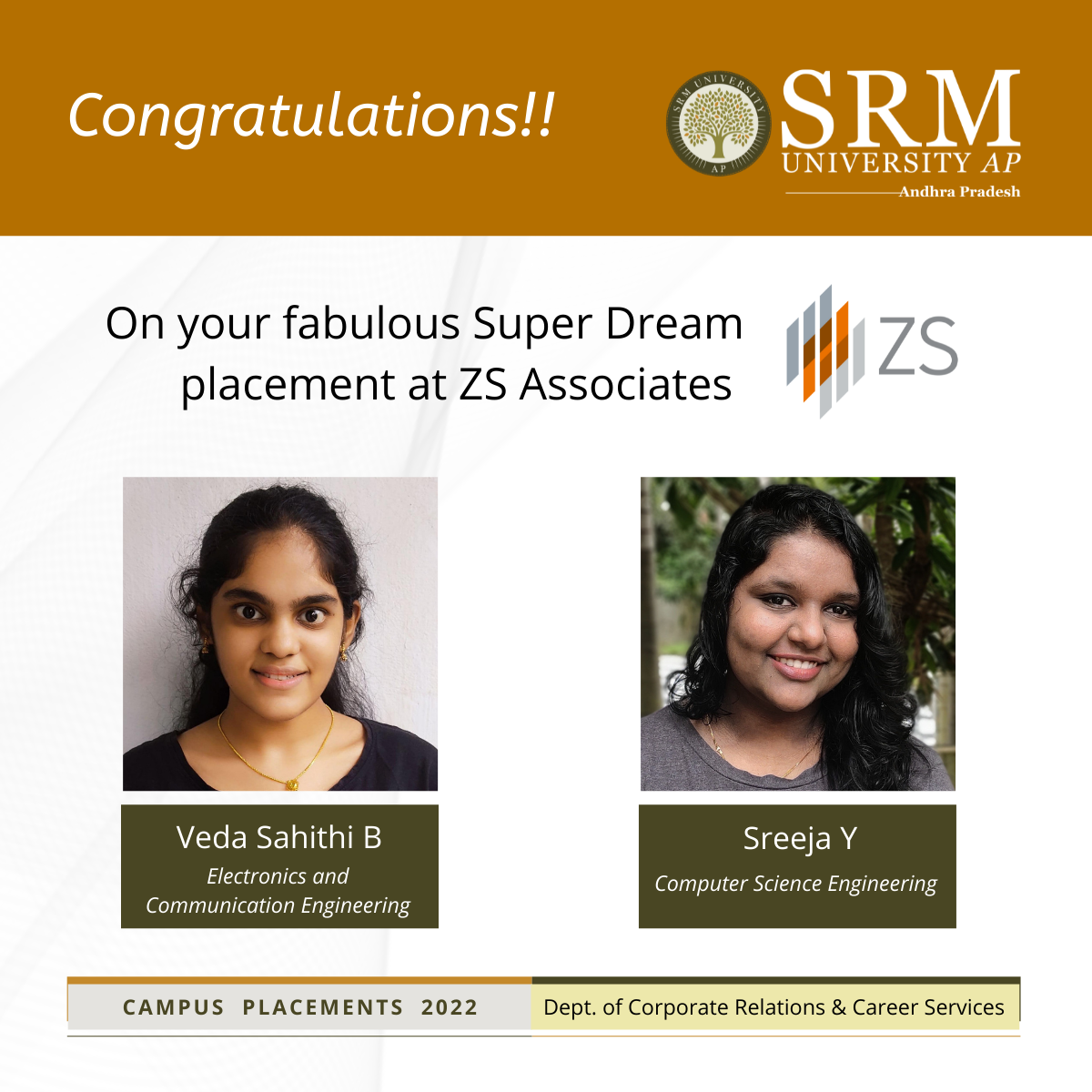 Bandi Veda Sahithi from the Department of Electronics and Communication Engineering, and Sreeja Y from the Department of Computer Science Engineering have been placed at ZS Associates with an exciting CTC of 14.35 LPA.
Bandi Veda Sahithi from the Department of Electronics and Communication Engineering, and Sreeja Y from the Department of Computer Science Engineering have been placed at ZS Associates with an exciting CTC of 14.35 LPA.
Students started their preparation two months prior to the month of placements (approximately April-May and placements started in July). Following a disciplined timetable, and the CCC training given by the university, students have achieved their dream job offers! As Sreeja Y is a Computer Science Engineering Student, she mainly focused on DSA, DBMS, OOPs, OS and Aptitude (sources she used to prepare are Geekofgeeks, YouTube, Hackerrank, Leetcode for coding, W3schools).
The Curriculum for placement provides intensive training for 1 and a half month where the students receive CCC training, Domain training (TIME), and Aptitude training. The CCC Classes helped students understand DSA concepts and apply those concepts in coding. In the Domain training students were taught DSA, CN, OOPs, OS and it helped them further in SQL, DBMS concepts.
Sreeja expresses her gratitude for the guidance, training and sources of knowledge she received from SRM University-AP. “Approximately 75 companies lined up for recruitment in a month. Placement Cell really gives us great and wide opportunities to achieve our goals.” “The placement cell is a wonderful interactive platform that connects various companies with the university, providing abundant opportunities”, added Veda Sahithi.
- Published in CSE NEWS, Departmental News, ECE NEWS, News, Students Achievements

